It was intended to be a short holiday for our anniversary. Ranthambhore near Sawai Madhopur in Rajasthan, home curently to over 30 “royal” bengal tigers. And I fell in love there. Our first safari ride into the Ranthambhore National Park, just before sunset, we sat and waited by the almost dry lake on one end of zone 3 of the park. Watched the herd of deer all looking in the same direction, watched their tense attitudes and our driver’s excitement… and waited patiently in complete silence. The only sounds were the alarm calls given out by the deer, their survival instincts kicking in though no tigers were visible to any of us at that time.
She left her cubs at a safe distance, and then walked slowly towards the waiting vehicles. She crossed the path, glorious in her orange black stripes shining like burnished gold in the fading light of the evening, the most exhilarating catwalk ever and ambled over to the water. She drank some water and then lay there for a few minutes, thirst quenched. Cursing myself for not having invested in the new lens, I borrowed a pair of binoculars from a neighbor and zoomed into her face. And just as I got her into focus, she raised her head and looked straight at me, lazing licking the side of her face. It was then, that precise moment when I fell in love with her. The ‘lady of the lake’ then walked through the tall dry grass and crossed the path in front of our vehicles, seemingly oblivious to her admirers and went back to where she had emerged from just a few minutes ago.
The park
Ranthambhore National Park is protected territory, spread over 280 sq km of varied fascinating terrain. Ranthambhore being dry deciduous forest, most trees had shed their leaves for the summer and the entire region was a riot of deep earthy tones, semi-parched brown and yellow, sudden fresh greens in between and the bright red ‘flame of the forest’ lighting up against the deep blue sky. Although Ranthambhore is considered one of the best places to spot the tiger, we are told before setting off that tiger sightings are a matter of chance and also more importantly, that there is much more to the Ranthambhore park than the tiger and therefore, it pays to keep the eyes open just to the ecosystem.
This is sound advice to remember – the park abounds with all sorts of life – from spotted deer, cinkara, sambar, langurs to lepoards and tigers. I am told that the park is also a bird-watcher’s delight – our excellent guide kept pointing out the different birds to us as we went along – I know he felt slightly annoyed when I pointed to a bird with slight pink feathers around the neck (it seemed exotic to me) and he said disdainfully – that is a common dove – dove with a pink neck and feathers? not common to me, no way. I attempted to soothe ruffled feathers (his) by admitting that I lived in Mumbai where the only common bird was the grey-throated Indian crow. After which he stopped talking to me completely and spoke to my husband instead.
Going back to what I was saying about appreciating the diversity of the park, it is best to soak in the surroundings and enjoy the ride – and consider tiger sightings a bonus. The website of Ranthambhore Bagh (the website is a great source of information about the area) where we stayed says this – It is is home to over 40 species of mammals, 320 species of birds, over 35 species of reptiles and over 300 species of plants. I know several people who came with us on the safaris completely disinterested in anything the guide or driver may have to show them – but where is the tiger?. Which also brings me to the other important lesson learnt – while keeping an eye and ears open for the tiger is a great idea, it is best to keep the mouth shut and just listen.
If you keep really silent, you may just be able to hear the tiger(s) laughing away at some great distance at the folly of the tiger-watching crowds – hunters and kings who once shot tigers for sport with great relish, poachers who still manage to get in and o their work in parts of the forest that are not officially “protected” by national park status… and now humans who come out in groups in the desert heat desperately seeking one glimpse of the gorgeous animal. If I were a tiger, I would be laughing for sure. And carefully studying wheel marks (the way we humans look out for pug marks of tigers in order to track their movements) and avoiding those routes!
At Ranthambhore, there are two safaris in a day – one that begins just after sunrise and the other in the early evening – depending on the season – each safari lasts for roughly three hours and each one can be an interesting experience. The forest takes on a different character each time you go through it, depending on the time of the day and even perhaps its mood. Part of the forest’s nature is shaped by the fact that it is the intersection point of two old and varied mountain ranges – the Aravalis and the Vindhyas, each with a distinct character.
Only a limited number of vehicles are allowed into the park for each safari – which is a good thing, considering how loud and crowded the huge open park felt during just two days of long-weekend crowds from Delhi. The core area (where vehicle movement is allowed) is divided into five zones and each vehicle is alloted a different zone. Each of these zones is different in terrain and topography, and we were lucky to get different zones each time we went in. Given the dry hot climate of Rajasthan, water understandably is most precious – life revolves around water in the region – there are people handing out water for passersby at several places, just as the animals themselves gather around the several small lakes and waterbodies that dot the forest region.
A note on conservation
Ranthambhore became part of Project Tiger in 1973 when the gravity of the issue of declining numbers of tigers was realized and the government began its serious conservation plans. There have been crises of varying dimensions since then, the latest as recent as a couple of years ago (in nearby Sariska, and threatening to affect Ranthambhore too). Although poaching has not been reported in the last few years within the protected area of the national park, there are vast areas of forest lying on either side, where the animals move around freely, and where there is no “protection” against poachers (who ironically cannot survive in the wild for a day on their wits along, without the guns and weapons).
Ranthambhore attracts committed naturalists and tiger-lovers and after tiger-sighting, the next best thing for me was sitting in the long hot evenings, listening to these stories from them. About Fateh Singh Rathore and his love for the animals and later the park itself, about tigers and lepoards coming out into the open and walking on the roads at night, about the villages which were once situated inside the area of the reserve and the villagers’ (not always expected or appreciated) encounters with wildlife.
I had the pleasure of riding on vehicles where the driver stopped suddenly (two different times, different people) on spotting an offending bit of plastic on the path. And guides who pleaded with tourists to maintain silence and not throw away their plastic into the open. It is so easy to do your bit to make the lives of the animals more peaceful – if not aid in actual conservation (who knows how much damage plastic does) – avoid loud clothes, loud noises. The tiger is just a beautiful animal, a loner with great elegance and dignity. I fell in love at first sight.
***
View : Ranthambhore photoset on flickr
Also read : Ranthambhore summer : the fort


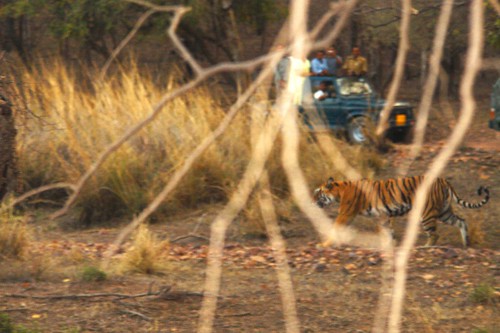

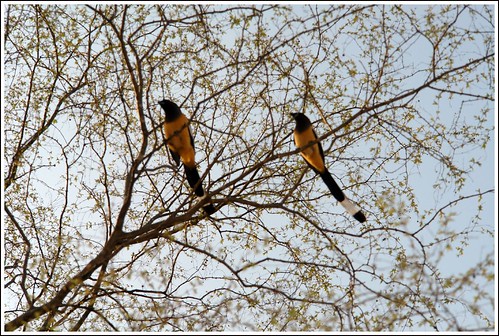

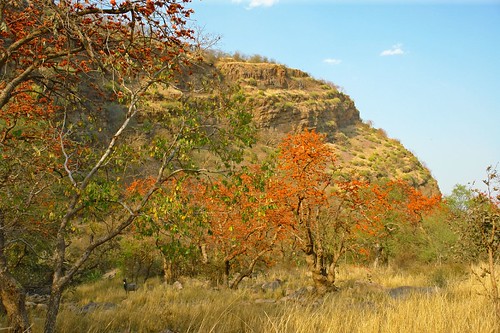
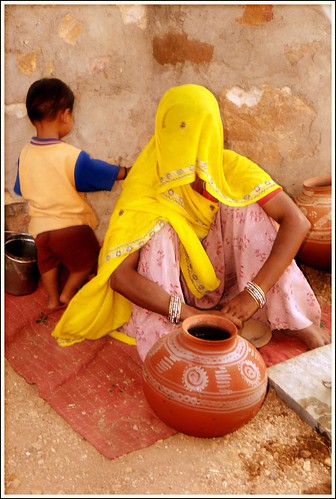
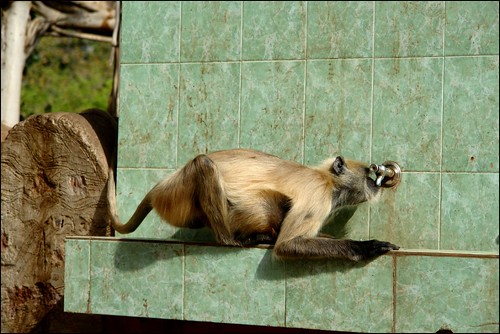


beautiful photographs and a most vivid account….
especially loved the photograph of the deer and peacock together at water… I had the exact same sighting at Kanha National Park few years back ..
Ranthambhore beckons!
I just loved this post. I especially loved the picture of the two monkeys (langur?) in the forest as well as the one of the monkey drinking from the tap.
The moment you mention flame of the forest, it reminds me of the beautiful amber riot. I had the fortune of meeting “Lady of the Lake” and she had the exact same effect on me. The striking beauty and those penetrating eyes…
Enjoyed reading your report. 🙂
I am planning to go to Ranthanbhore this month on one of the convenient weekends and i was looking at a few blogs for some information when i came across yours. I must say that it is one of the better travel blogs i have come across.
Thakn you for the informative posts and the stunning photographs.
Cheers!
beyondlust, hey, thank you! I hope you have a great time at Ranthambhore…